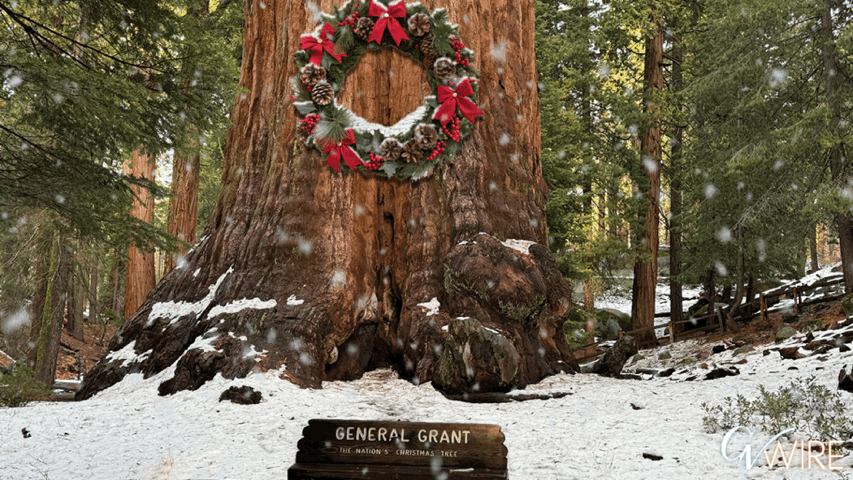Share
|
Getting your Trinity Audio player ready...
|
Morgan Doizaki reflects often on the stories his mother used to share about how Japan built the world’s first bullet train, the Shinkansen, in the early 1960s.

Yousef Baig
Opinion
CalMatters
The country between Tokyo and Osaka was “probably one of the worst pieces of land you could choose,” Doizaki remembers her telling him. There was little reason to stop – until the train arrived. The economic payoff was significant, and these areas became some of the most desirable communities in Japan.
With construction crews at work building the first major stretch of California’s high-speed rail, the Central Fish Company owner wonders what it could do for his hometown. His family has spent seven-plus decades running a seafood market at the city’s southwestern front door.
“I’d love to see that happen to downtown Fresno and Chinatown and the surrounding areas,” Doizaki said.
In five years, Fresno’s core will be transformed into the first major hub on America’s most ambitious active infrastructure project: a 500-mile bullet train shuttling people 200-plus mph from San Francisco to Los Angeles in under three hours. But unlike Interstate 5, the state’s north-south connector, it’ll run through the heart of the Central Valley.
If you listen to California’s political class, the high-speed rail project sounds like a textbook boondoggle – over-budget, delayed and larded up with waste. Yet in communities across California’s farm belt, the discourse is refreshingly different.
It’s a symbol of transformation for a region that’s already bursting with activity. As the population declines in much of California, the Central Valley is growing, and forecasters say it will welcome 5 million new residents by 2060.
High-speed rail’s success will likely shape the region’s future, helping diversify its economy, build more housing, and revitalize cash-strapped cities. But despite a litany of unmistakable benefits for California, the project remains a political pariah — pleading for a breakthrough in a bad-faith debate over the remaining budget gap.
Polls show that most Californians still support high-speed rail, yet the prevailing narrative is often the cynical one. For Republican delegations that serve in the state Legislature and Capitol Hill, the $128 billion project remains a punchline, a “train to nowhere” – or as President Trump once put it, linking a “tiny little town to another tiny little town for billions of dollars.”
Even Assembly Democrats, including former Speaker Anthony Rendon and ex-transportation committee chair Laura Friedman, have soured on the project.
But in the Central Valley, high-speed rail is not an imaginary pipedream. And it’s certainly not a train to nowhere — it’s where they live. Fresno’s Republican mayor, Jerry Dyer, says he’s “more than a proponent. I’m a strong proponent.”
As state and federal governments invest hundreds of millions of dollars to revitalize downtown Fresno and other cities in the valley, people who have been ignored for generations now have a seat at the table, helping plan for new homes, hotels, restaurants, and retail.
Finally, places like Chinatown will be a destination.
“You’re going to see a lot of Fresno, Fresno, Fresno, Fresno, and it’s going to keep happening,” Doizaki said. “It’s our time right now.”
‘The State Slapped Fresno’
On a quiet fall morning, the only signs of life in Chinatown Fresno were a pack of stray dogs playing where California plans to build a sleek train station. It’s hard to imagine, looking at it now. Orange safety fencing separates empty streets from a staging area full of lumber, rebar, pipes, and a few portable toilets.

A handful of lived-in cars dotted G Street, and a few people were sleeping in shop alcoves a block away. Most businesses close after lunchtime. Central Fish shuts down at 6 p.m., for example, the latest of any shop in the neighborhood. Boarded windows, vacant storefronts, and nearly a dozen undeveloped lots line a community physically cut off by train tracks and highways.
The city’s first settlers — many of them Chinese — were forcefully relocated here in the late 1800s. They built the multicultural community brick by brick, and much of the mason work is still intact. But urban renewal in the 1960s devastated the neighborhood, UC Berkeley scholars noted in a case study last year. Businesses and residents were displaced by freeway construction, sowing a deep distrust of government among those who stayed. As white flight to outlying communities stretched the city’s boundaries, southwest Fresno stagnated, enduring decades of hardship and neglect.
The collapsed remains of the 103-year-old Bow On Tong building – most of it destroyed in a 2022 fire – feel like an eerie metaphor for the community’s history and the limbo of today.
Since high-speed rail was formally routed through the Central Valley some 12 years ago, California has paid significant attention to the neighborhood. Fresno was selected by the state’s Strategic Growth Council for a $66.5 million pilot program to build eco-friendly communities in areas that were cast aside after urban sprawl. One of the first projects, The Monarch — a trendy four-story building with 57 units of workforce housing — is now open.
It’s tempting to cast the revitalization as gentrification, but Chinatown business owners came together almost a decade ago to increase their bargaining power. The goal was to ensure their community is upgraded rather than replaced. Golden Cuts owner June Stanfield, a southwest Fresno native, has been one of the most prominent voices, ensuring the neighborhood is “thinking of the future.”
“Get rid of the negativity because we’ve had negativity in this area for over 50 years already. There’s no room for that anymore,” Stanfield said in an interview. “You have to start somewhere.”

For now, they’re at the whims of slow-moving bureaucracies that only show urgency when there’s a press conference or deadline. Some of the streets and sidewalks are impassable, and the impacts are squeezing the businesses further, deterring even the most loyal customers, Doizaki said.
The anticipation can be overwhelming at times, but high-speed rail has been “a blessing in disguise,” he told me, delivering long-sought economic justice and unparalleled investment.
“The state slapped Fresno in the face and said, ‘What the heck (have you been doing)?’ This is the state’s largest project ever. If it wasn’t for high-speed rail, we wouldn’t even be having this conversation.”
Absent Federal Government
On one of the last summer-like days in October, a handful of construction workers were tying rebar atop a seemingly endless viaduct east of Hanford, the seat of Kings County. At 6,330 feet long, it’s the largest of some 30 active construction sites in the San Joaquin Valley. The exposed, reinforced steel will form the skeleton of parapet walls that flank both sides of the tracks.

Between plum and walnut farms below, about a dozen hard hats tilted back at a makeshift production facility, their wearers carefully watching a crane lower a bucket filled with fresh cement. Everyone had a specific task, helping mold an 84-inch, wide-flange girder that would be stored nearby until it got added to the viaduct.
California is handling much of the manufacturing work in an unusual manner: onsite and in-house. The Hanford viaduct, which will later link to the Kings-Tulare station between Bakersfield and Fresno, will be completed next year.
When nearly 53% of voters approved the $10 billion bond to launch the project in 2008, they were told an 800-mile network would be running by 2020, and it would only cost $40 billion. The project footprint has shrunk considerably – some 300 miles – and the most optimistic price tag is $88 billion. The higher end of the estimate, $128 billion, is also pretty optimistic.
With delays, comes inflation.

High-Speed Rail Is Advancing
But high-speed rail construction is further along than many Californians probably realize. Officials hope a 119-mile portion of the Central Valley segment from Merced to Bakersfield will be complete by 2026. A share of the $3.1 billion grant the Biden administration just awarded will help purchase the project’s first trainsets, which the authority is already seeking bids for. The first tests are slated for 2028, and the first passenger ride will embark between 2030 and 2033.
The rail authority has secured environmental clearance for nearly the entire network from SF to L.A. Gaining full clearance allows project officials to start design work, land acquisitions and construction for the entire route. The remaining segment, a politically charged and tunnel-heavy bend from Burbank to Palmdale, will begin the public review process later this year.
The biggest outstanding question is also the oldest: funding. California has provided 85% of the more than $23 billion allocated so far, creating an unsustainable dependence on a depleted bank of bond money and a cap-and-trade climate program expiring at the end of the decade.
The federal government, which usually covers most infrastructure costs, has been largely absent, susceptible to the political pendulum of the White House and Congress – and unable to break decades of road-building inertia. California and the rail authority even had to file a lawsuit to stop the Trump administration from clawing back a $1 billion grant in 2019.
Things have been much chummier under “Amtrak Joe,” and the authority hopes to collect as much as $8 billion from the president’s trillion-dollar infrastructure law. The recent $3.1 billion announcement was the biggest federal grant yet.
Rep. Jim Costa, a longtime backer and Fresno-area Democrat, promised a steady supply of federal funds to support the California project and others nationwide. He introduced legislation two years ago that would have provided $32 billion for bullet train projects but the bill went nowhere. Last month, Costa signaled he would try again, but it’ll ultimately require bipartisan support.
There’s no money to connect the system to the Bay Area and Southern California until the federal government steps up. Authority officials last year wrote in a business plan update that funding “will have to be permanent and substantial at both the federal and state level, as was the case starting in the 1950s for highways,” if the project has any hope of reaching California’s coastal hubs.
California’s High-Speed Dream
The main phase of the high-speed rail project would connect Los Angeles to the Central Valley and San Francisco Bay Area, passing through cities including Palmdale, Fresno and San Jose. While it’s estimated that the first phase of the rail system could be online in the 2030s, the second, which would expand south to San Diego and north to Sacramento, is still in the planning phase.
America’s spreadsheets reveal her priorities. Between 1949 and 2017, the federal government invested $777 billion in aviation and over $2 trillion in highways. High-speed rail received just $10 billion.
However, things may finally be shifting. Transportation Secretary Pete Buttigieg last month vowed to reverse the trend after putting aside more than $6 billion in high-speed rail funds. Half went to a private project, Brightline West, aiming to link Southern California to Las Vegas in time for the 2028 Olympics in L.A.
‘What the People Want’
When Interstate 5 was built in the mid-20th century to connect Northern and Southern California, the decision to bypass the Central Valley was intentional. That piece of history lingers with Fresno Mayor Jerry Dyer.
“The fastest route was between two points,” the retired police chief said in an interview. “Well, unfortunately, the valley wasn’t part of those two points.”
Dyer is a self-described fiscal conservative but finds his city in “God’s favor right now,” as he helps shepherd an era of dramatic transformation. The state is giving Fresno $250 million to overhaul its aging downtown infrastructure, an investment expected to spur a wave of new development in the city’s core. High-speed rail is anchoring the plans. The feds have also provided $20 million to help cover the bulk of the train depot restoration.
Over a late afternoon coffee, Dyer explained the “tremendous divide between the left and the right” on the high-speed rail project. Like abortion or gun control, “I have to be careful when I’m talking about it publicly – and how I talk about it,” he said. “But I’m never going to shy away from the fact that I’m a proponent.”
When facing skeptics, Dyer describes his position as “pro-business.” He views high-speed rail as a “way to dramatically increase our revenues through a better economy” – even if it means more people from Silicon Valley living in Fresno.
“I don’t want to be remembered as the mayor that blew an opportunity to revitalize downtown and had all the resources and money to do it,” Dyer said.
That pragmatism seems to fade in higher offices. Assemblyman Vince Fong, a Bakersfield Republican and potential successor to Rep. Kevin McCarthy, strangely stated he was unsure if he’s ever supported the project, but conceded, “I can understand where Californians were intrigued by the project.”
The bottom line, he told me, was its “record of gross mismanagement and broken promises” warrants a total shutdown.
To be sure, the authority has had an objectionable past. The California State Auditor wrote several scathing reports over the last 13-plus years, calling out the project’s weak oversight, inadequate planning and careless contract management. For years, the authority empowered a small army of consultants, resulting in high turnover and years of mismanaged agreements that totaled millions of dollars. It’s unclear whether the work was even done, the auditor’s office said at the time.
The consultants in charge often took years to pay farmers and landowners, sacrificing goodwill and early political support. Critical services such as homeless shelters in Bakersfield, for example, were forced to relocate.
The authority has noticeably improved in recent years, but many state and federal leaders aren’t convinced. Considering the attractiveness of antagonist politics, some might never come around. Fong is so cynical about the project that he questions why the first phase runs through his district.
“Other countries, when you look at their high-speed rail system, they’ve connected major urban centers to other major urban centers,” Fong said. “If you were to have this discussion again … well should they have started from L.A. to San Diego? Should they have started from Anaheim to San Diego, for example – pick your urban center.”
The federal government picked the Central Valley, hoping to boost the region’s economy in the aftermath of the Great Recession. The Obama administration prioritized Fresno and Bakersfield – the former surpassed only by Los Angeles, San Diego, San Jose and San Francisco in terms of population, and both larger than Anaheim. In 2010, the Federal Railroad Administration doled out a $715 million grant to begin construction of the first segment.
The state Legislature endorsed the route two years later.
The aversion to high-speed rail in today’s discourse resembles the most cancerous form of local government: a fixation with complaining about problems rather than solving them.
For Ray LaHood, a retired Republican congressman and high-speed rail evangelist, that manifested when red-state governors rejected billions of dollars because it came from a Democratic president, or furthered a plan by a Democratic predecessor. When LaHood served as Obama’s transportation secretary, governors in Wisconsin, Ohio, and Florida all turned down money for high-speed projects.
California wasn’t immune. When McCarthy served in the state Assembly, he backed legislation championed by Republican Gov. Arnold Schwarzenegger. When Democrat Jerry Brown returned to the governor’s office and Obama was in the White House, McCarthy had a change of heart. Infrastructure projects became needlessly politicized, obscured by corporate spending and shadowy special interests.
Public sentiment has been less fluid. Almost 53% of California voters backed the ballot proposition in 2008, in the middle of a downturn and with reports saying the cost would reach $100 billion. A 2022 poll by the Berkeley Institute of Governmental Studies found that 56% of registered voters still support the project, including 3 out of 4 Democrats and more than half of independents.
“When California is finished, it will end up being a good investment. People will use it,” LaHood assured me. “It’ll be oversubscribed just like it is in Japan, just like it is in Europe, just like it is in China. This is what the people want. For politicians to turn a blind eye to what the people want, it’s just not right.”
California Paradox
The issue of cost overruns, delays, and mismanagement are not unique to high-speed rail. They’re actually a cornerstone of public works projects – as is opposition. The Golden Gate Bridge famously overcame 2,300 lawsuits before construction even started.
Inflation and economic swings have become unbearably common in recent decades, and that’s made building anything of importance seem futile. In many ways, the problems with high-speed rail have become less about the project and more about California’s modern paradox: In no other state is such ambition possible, and in no other state is building so difficult.
The Central Subway in San Francisco, for example, which began service in 2022, was more than $375 million over budget and four years late. The BART extension to San Jose is expected to cost double the initial price tag and open 10 years later than planned. L.A. Metro’s regional extension opened last summer three years late and hundreds of millions of dollars over budget.
The most common bullet-train critiques consistently downplay its upsides, or fail to account for the wholesale changes the state is already undergoing, as affordability issues push more of the workforce inland. Instead of demanding that tax dollars are spent on projects future generations will cherish, momentary complaints have allowed political leaders to sidestep a voter mandate.
Perhaps the most important resource the bullet train restores is what roads and highways dispassionately consume: a person’s time. Although, the project’s $181.4 billion economic output is pretty good, too.
For Brown, who helped secure the first batch of federal money from Obama, the ability to build infrastructure projects sends a message about a nation’s stature. “America is not going to be a leading factor in the world if we can’t build stuff,” the ex-governor said recently.
“There are a lot of carpers and complainers and Lilliputian minds that try to stop us,” Brown continued. “…This is a question of can America make it or not? I say we can.”
The apolitical argument Brown offers may also be the simplest: High-speed rail is a debate between optimists and cynics, a gut check on the public’s winnowing faith in government institutions and our ability to make them do their jobs. Whether the political will materializes or inaction wins the long game, California high-speed rail has become another window to the American psyche.
And some of the hopeful reside in one of the most neglected corners of California: Fresno.
About the Author
Yousef is the California Voices editor, overseeing the commentary section for CalMatters. He previously worked for The Sacramento Bee, where he was the assistant opinion editor and a member of the editorial board, covering the city and a variety of state issues. Before that, Yousef spent nearly six years working for local newspapers in the North Bay Area. Yousef was born in Anaheim but raised in the Atlanta area, and earned a journalism degree at the University of Georgia. He returned to California in 2014.
About CalMatters
CalMatters is a nonprofit, nonpartisan newsroom committed to explaining California policy and politics.




















